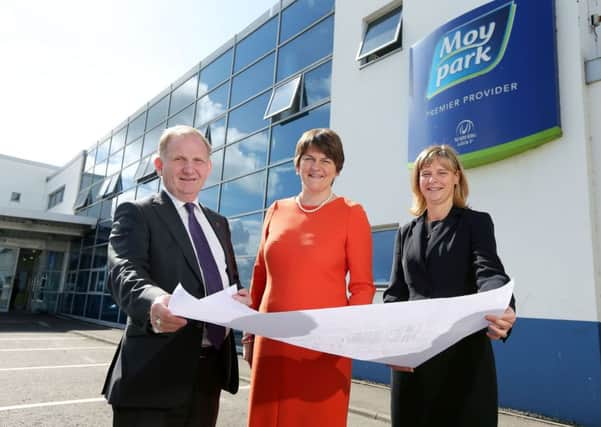Inquiry reveals how huge poultry firm Moy Park cashes in by squeezing farmers


He said that the company – which once paid the full cost of gas heating for poultry houses – was able to slash the proportion of heating it paid for, knowing that farmers were getting the RHI money to effectively cover the gap.
David Mark said he did not accept that but eventually agreed that indirect hot water heating had played a part in improving efficiency of Moy Park’s farmers. However, he insisted that it had “a minor part to play”.
Advertisement
Hide AdAdvertisement
Hide AdDetailed scrutiny by the inquiry of heating figures show that Moy Park pays its farmers considerably less for heat than what its internal documentation describes as reasonable.
Mr Mark described in a document heat usage of between 1,800 kwh and 2,000 kwh per thousand birds as legitimate – and elsewhere Mr Mark suggested to a bank that a poultry farmer could use 5,000 kwh and it would be reasonable.
However, Moy Park only pays its farmers for about 1,400 kwh of heat per thousand birds – a significant financial benefit to the company.
Inquiry chairman Sir Patrick Coghlin said that it seemed clear from Mr Mark’s own work – where he had gone to farms to gather evidence of genuine heat usage – that he knew farmers needed more heat than Moy Park was prepared to pay for.
Advertisement
Hide AdAdvertisement
Hide AdHe said: “The problem, I think, for myself anyway, is where you do have evidence which you have here – it’s empirical; you’ve gone out to the farms; you’ve developed an average on those figures and yet what you called the economic, conservative allowance is... 400 below the average produced by actual evidence.”
Mr Mark said he still felt there wasn’t a “statistically relevant sample” due to the limited data he had.
Sir Patrick said: “Whether you had a statistically relevant sample is a matter for you.
“If you wanted a statistically relevant sample you would have had a pilot scheme... what you do is a practical visit to a number of farms and for me anyway, Mr Mark, I just don’t see any escape from the fact that you’ve taken a figure smaller than the lowest part of the range – to benefit Moy Park.”
Advertisement
Hide AdAdvertisement
Hide AdMr Mark said: “My intention and my understanding is we are trying to understand what is the legitimate, reasonable usage.”
The Moy Park manager said he was “trying to guard against” wasteful use of heat by setting the heat allowance where it was.
However, it was highlighted to Mr Mark that his own figures for reasonable heat usage – not abuse – were much higher than the allowance which Moy Park gave its farmers.
Sir Patrick said to him: “But you’re not suggesting for a moment that... guarding against waste was responsible for this calculation?
Advertisement
Hide AdAdvertisement
Hide Ad“You can’t do that because you have said these all point towards responsible use.”
Initially, Mr Mark denied that he had ever seen RHI as a “safety net” for Moy Park’s suppliers.
However, barrister Donal Lunny showed him a document where he had used that precise phrase
saying that if a Moy Park farmer was struggling “with biomass at £20k and AHP at £60k, they’ve £80k income assured - the other £50k of bird income may fall to £30k. It’s not a total unrecoverable disaster; the £20k RHI is a big safety net”.
Advertisement
Hide AdAdvertisement
Hide AdMr Mark insisted that was “in a different context” where he was talking to the banks about lending to farmers and RHI “did change the dynamics of the investment and it meant that those [least efficient farmers] had a little bit more cover”.
He said that for a farmer who was struggling “this one known was the RHI figure and it just changed the dynamic of the calculation and it’s a safety net in that sense”.
Dr Keith MacLean asked whether that meant “the RHI is providing a subsidy to the industry”.
Mr Mark said it was giving an income to the farmer “and that was a fixed income that was known” and would help a struggling farmer with loan repayments.
Advertisement
Hide AdAdvertisement
Hide AdDr MacLean said that the evidence related to “the economics of the activity and what you’re saying is that what would have been an unrecoverable disaster is now no longer that, which means that [taxpayers are] subsidising not just the heat production and the fuel costs but the activity as a whole and that’s surely not what the RHI was ever designed to do.”
Mr Mark said: “I don’t think it was doing that. The point I was trying to draw to your attention was: They’re going to borrow £620,000 and they’re going to have a return which will cover that £620,000. If they’re [among the least efficient] that return gets quite, gets lower - if they’ve borrowed another £60,000 with a guaranteed income from RHI, that’s one piece of fixed income.”
Mr Lunny put it to the witness that if the RHI income was making up for a shortfall between Moy Park’s fuel allowance and farmers’ actual fuel use “there was a potential indirect benefit to Moy Park from that...it was meaning Moy Park didn’t have to make up the difference as quickly as might otherwise have been the case”.
Mr Mark said: “If that was correct, yes....however it was always out intention to pay 1:1 [for all necessary heat].”